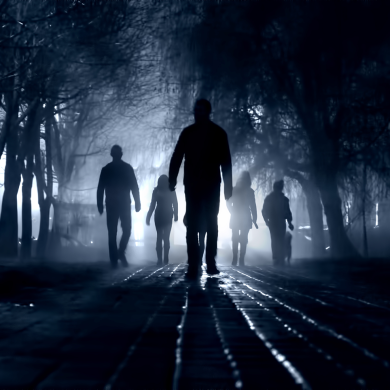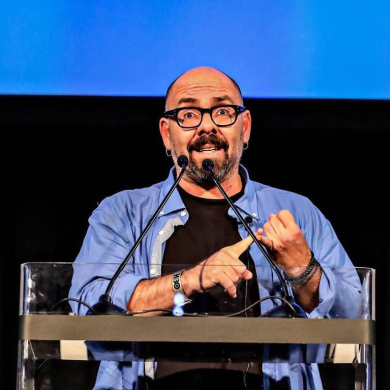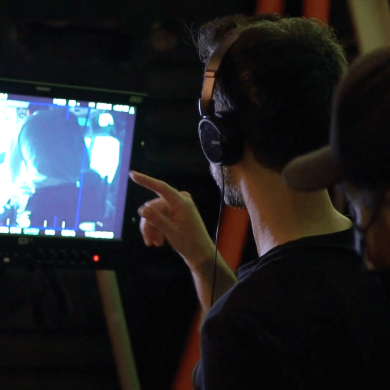By Justin Sanders
It’s a quiet day at Infinity Arts Studio, where owner and proprietor Jay Ryatt recently completed a project for one of his aerospace clients. His slate is clear – which means it’s time to get creative.
“So now I’ll be out there,” he says, “building this big old tornado a customer wanted.”
Ryatt points toward a far corner behind his house where, sure enough, an intimidating jumble of metal rods, chains, and rusted spare parts has somehow been formed into a towering sculpture of a tornado, replete with a bicycle, windmill, ruby red slipper, and other objects that have been swept up into its powerful current. “It’s a Wizard of Oz thing,” Ryatt adds, by way of explanation. “It has a little yellow brick road and everything.”
Ryatt, an “aerospace welder by trade,” was brought into the tornado project by a client who had “some type of problem with his brain and he thought he was going to die,” he continues. “He didn’t know what the hell was going on, but he and his wife found their way to one of my art shows and they went into the backyard and we started pulling some parts together, and it ended up turning into this Wizard of Oz tornado that represented what was inside of his head. He’s going to put it in at his house and it’s going to turn and everything. It’s pretty cool.”
It’s important to emphasize that Ryatt delivers all of this information with utter matter-of-factness. There is nary a twinkle in his eye nor a smile on his face. Making a work-related heel turn from the world of aeronautical engineering to the mind of one Oz-obsessed individual is par for the course for this artist, whose entire life has been a journey of similarly fascinating dimensions. It’s also all the evidence you really need that the Infinity Arts Studio tagline, “You Dream It, We Create It,” isn’t just some slick marketing message. In Ryatt’s seasoned hands, it’s simply something you can count on.
B.C. (BEFORE CREATIVITY)
For most people, the notion of cutting and shaping and twisting metal, some of it weighing thousands of pounds and more, doesn’t just seem challenging – it seems impossible. Where would you even begin? For Ryatt, it began with his passion for motor sports. Born in Kenya and of Indian descent, his parents were electrical contractors who enjoyed off-road racing and worked on “safari stuff” at the nearby game park. Eventually, his father procured a job with Pan American World Airways (PanAm) along with an opportunity to move to the United States. The family lived for a brief time in New York before, “with $500, a Mustang, and a U-Haul to our name, we traveled across the states like pioneers,” Ryatt said, “all the way to California.”
They wound up in Santa Clarita, a city north of Los Angeles best known for the Six Flags Magic Mountain theme park, but beloved by locals for its rolling hills, quiet vistas, and ample opportunities for outdoor recreation. As a teenager, Ryatt “had no idea I would be an artist,” he said. He loved riding dune buggies and dirt-biking through the nearby canyons on his Datsun 510. The only problem was, “when you go out and punish those things they come back broken,” and Ryatt didn’t have any money. So, he repaired the vehicles himself – learning the basic welding and metal fabrication skills needed to keep his favorite pastime up and running. But what began as a hobby quickly became a profession as Ryatt discovered he had a knack for welding and began taking on paid gigs out of his parents’ backyard.
Eventually, Ryatt saved up enough cash to put a down payment on a small house on a lot in Green Valley, a neighboring berg nestled in the foothills of the San Bernardino Mountains. There, his business flourished, with clients pouring in from the world of Motocross sports, but also from the local machining and aerospace manufacturing companies. Some of the parts he built, for airplane manufacturers and other clients, were 200 feet long and 50 feet wide, constructed on “machines that are as big as this house,” he said, gesturing toward his residence. Other builds, once he became certified as a titanium welder, were “real small, intricate parts” for projects ranging from bomb parts to x-ray machines. Some of his jobs required top-secret clearances that he refuses to discuss to this day, decades after the fact.
Business was good. And then, sometime in the late ‘90s, Ryatt “got into the amusement stuff.”
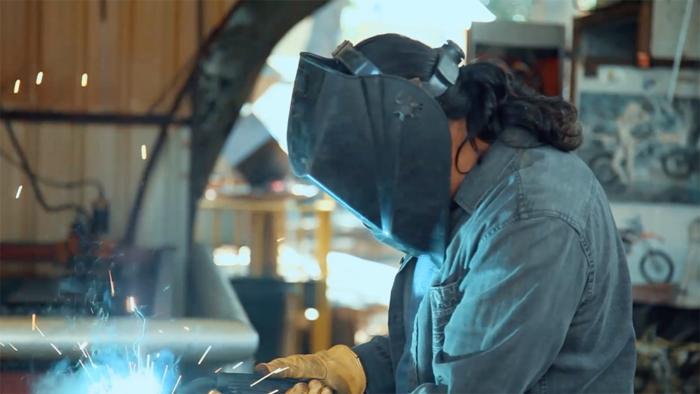
THE FIRE STRIKES
Some artists have the creative itch from the moment they are born. For others, creativity strikes later in life, like a match, and the fire begins. For Jay Ryatt, that strike occurred when, after years working for clients like Boeing and the U.S. government, he contracted with a place called The Attraction Services Company.
Despite its dry-sounding name, Attraction Services designs and builds what are, factually speaking, the most thrilling metallic structures in the world. Attraction Services constructs roller coasters. They also build other kinds of rides, as well as show-stopping, effects-driven installations such as the Waterworld show at Universal Studios, and a live pyrotechnic spectacular culled from the film, Backdraft.
Ryatt began welding pieces for Attraction Services projects such as the Jurassic Park roller coaster at Universal, and found himself immersed, quite literally, in what had previously been, to him, The Lost World. It was the world of imagination, where “we would build things from somebody’s dream to a full-blown reality ride,” he said.
Ryatt’s job was to craft the steel supports for the massive foam characters that tend to populate many amusement park attractions. It wasn’t necessarily the most exciting corner of a given project, but Ryatt was inspired all the same. “There’s so much to it,” he gushed in retrospect. “The whole production of building these attractions, the collective creative mindset, and the engineering end of it all… I was around tremendous artists all the time who sculpted these massive characters and it was never the same thing twice. Your artist’s mind is always working to create. You’re constantly thinking.”
Ryatt didn’t realize it at the time, but a switch had flipped in his brain. His desire to create his own artwork had gone from “off” to “on.”
One day, while at the beach, Ryatt came across a large, granite rock that “looked like a lizard to me in my mind,” he said. The oddly reptilian shape of the stone compelled him to load it up into his truck and bring it home, where he happened to have a bunch of metal triangles and gussets – the leftover support pieces from a recent structural project – lying around the work station. Ryatt welded the pieces on and around the granite, turning his imagined reptile into a fully realized, long-tailed metal lizard who seemed to be holding up the rock. It was his first time ever creating a project simply for the artistic pleasure of it, and “it turned out really, really cool,” he said.
Also, really cool: the lizard sold for $2,500. “I was like, ‘I gotta go make me another one of those,’” Ryatt said. “That’s how it started.”
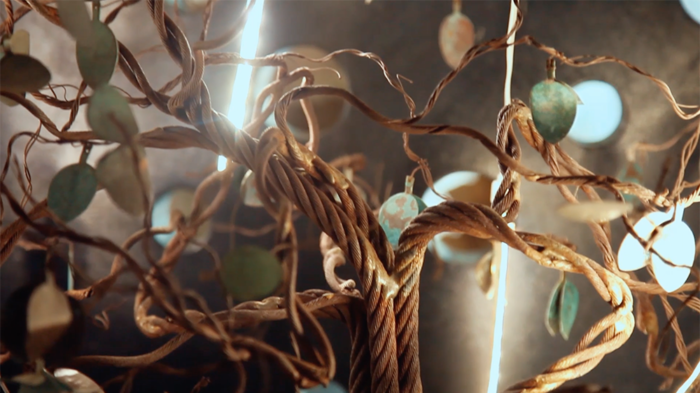
THE DREAM CONTINUES
After the surprise success of the lizard rock, Ryatt began “playing around” – building additional art pieces, each one wildly different than the last. “I see things in my mind and I think about what materials and supplies and equipment I have to build it, and if I see it come together in my mind, I’ll just go out there and do it,” he said.
Ryatt started displaying his metal sculptures in the quirky Los Angeles creative hub known as the Brewery Art Colony. He had done some steel work in the former Los Angeles Brewery building there, and quickly found himself swept up in the area’s famed Art Walks, in which hundreds of the local artists open up their studios to more than 10,000 visitors. Ryatt already had a studio, in Green Valley – but he would hire a crew to transport his myriad, often extremely heavy pieces across the 55 miles to the biannual event, and set up elaborate booths that “blew people away who were living in the area.”
Success in selling pieces at the Colony motivated Ryatt to purchase a plasma cutter, a high-precision machine for fine-detail metalwork. It is the plasma cutter that allows him to do what appear to be impossible things, such as bend and warp metal into a tornado. Now able to craft increasingly nuanced pieces, he started “doing shows all over the place” – loading up his motor home and lugging his wares to craft fairs and other events up and down the California coast. Eventually, he brought the art walk concept into his own neighborhood, inviting hundreds of people to tour his property and the properties of other artists in the area. The Green Valley Art Walk, as it was known, became a buzzworthy happening in its own right, replete with sponsors and vendors. It lasted 12 years in a row, until Ryatt decided to shut it down over insurance reasons.
Through years of exhibiting his wares, Ryatt learned that art shows were great for selling projects, but they were even better for selling concepts for future projects. Ryatt eventually began leaving his bigger pieces at home, instead creating mock-ups of them on panels so “potential clients could see what I was capable of without me having to drag it out every time,” he said. “What I’ve learned at these booths is, it’s hard to sell something right onsite. You don’t get a lot of impulse buys. It’s what the person thinks of later down the road. You get their information and then you call them back after the show, see what they want, and lock in a deal. That’s the way it works for me – put the product out, get some exposure, and pick up clients for custom orders.”
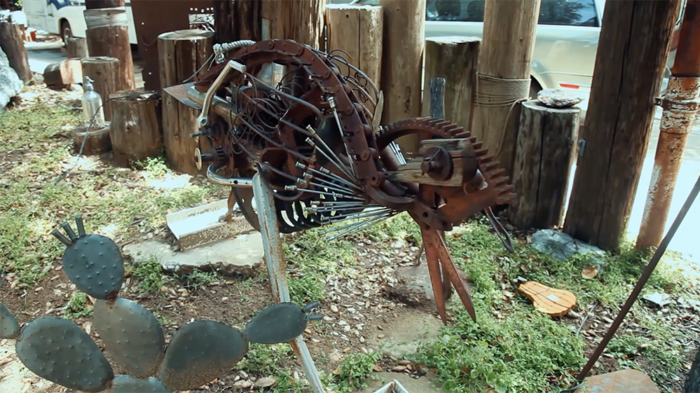
But beyond booths, it is the art walks themselves that have perhaps shaped Ryatt’s artistic approach more than any other kind of exhibition opportunity – so much so that he has incorporated the very concept of the art walk into his business model. Today, his brochures offer clients the chance to design their own art walks, custom pathways through their landscape of choice, elegantly strewn with Ryatt’s signature metal gates, bridges, handrails, and other works that can be made to order. Ryatt’s property serves as a kind of funky proof-of-concept in its own right, with its own pathway winding in and around an eclectic array of impressive-looking machinery and sculptures in various stages of completion.
Inside the house, a coiled snake dubbed “The Happy Viper” somehow bounces up and down like a spring despite being made of heavy steel. Schools of galvanized steel fish shimmer on the walls and sheets of decorative metal seem to cover every inch of the airy kitchen. Outside, among other objects, there’s a hulking wood-fired pizza oven that looks like something out of a Guillermo Del Toro film, a looming robot made of twisted piping and other parts, and an enormous, fully functional barbecue smoker that was used as a prop for the FX show Justified. (Discussing the smoker in an interview, the show’s set decorator Shauna Aronson explained that their only requirements for Ryatt were that the smoker be “fully functional and could only be made out of used items found on his property.”)
It’s not surprising, given his proximity to Hollywood and his work on Hollywood-branded amusements, that Ryatt’s work would inevitably brush up with the actual entertainment industry itself. His earliest show-business-adjacent effort involved helping construct an aluminum tank that Michael Jackson utilized in the epic stage show for the iconic HIStory World Tour. He’s also created flame effects for one of Howard Stern’s houses in the Hamptons, and a stair case for one of Johnny Depp’s properties.
Ryatt doesn’t like to make a big deal out of working with celebrities – “you don’t talk to them at all, just their people,” he says – but he was quick to mention how beneficial a show like Justified can be for a community like Green Valley. Ryatt rented his smoker to the production for the duration of its run, earning money for his efforts across all five of its seasons – but he was hardly the only area resident who received a boost from the series. When film and television productions shoot on location, they can create jobs for hundreds, if not thousands, of local businesses, ranging from catering companies to, say, a welder who makes fascinatingly quirky metal sculptures in his backyard.
“It’s good for the community when something like that happens,” Ryatt said. “Everyone gets a little piece of it.”
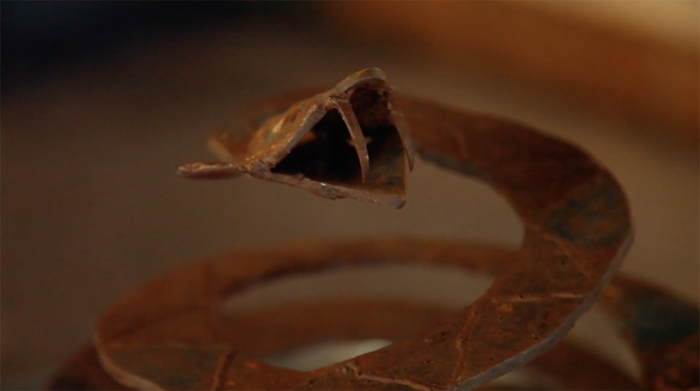
ALL ABOUT THE VISION
Ryatt refers to himself as an “exotic metal specialist,” meaning he can weld metals such as aluminum and titanium, materials that must be “welded in a very clean, controlled atmosphere, such as a welding chamber.” These are metals so sensitive, simply touching them during the process can “contaminate the weld, put color into it,” he said. A complicated vacuum system involving inert gas and a cool-down phase must be implemented – and is generally reserved for the most high-level, sensitive metallic objects imaginable, such as spacecrafts.
Looking around Ryatt’s rural, rustic property with its piles of scrap metal and garage lined with bikini babe posters, it’s hard to imagine parts for a spaceship emerging from here, but Ryatt swears his shop “is all set up for that.” Still, he prefers to work with the scrap, which is far less tedious and lets him tap into his ample creativity.
“It’s all about the vision for me,” he says, loading a couple pizzas into the oven. “Seeing something and knowing that I have the tools and materials to build it.” He loves welcoming anyone – potential clients or even just passers-by – onto his property and letting them roam. “The possibilities are endless,” he says. “My art works are displayed here so that customers who walk here can see what’s possible, and if they like something we’ll figure out how to create it at the scale they desire.”
After decades as an industrial-scale welder, Ryatt has completed the journey from motor sports enthusiast to a maker of visions that delight and beguile. He has become, inarguably, the thing he never, as a young boy fixing up the suspensions and busted shocks of his much-adored motorbike collection, dreamed he could be.
“I’m 52 now,” Ryatt says with a wry grin, “and I like to say I’m an artist.”
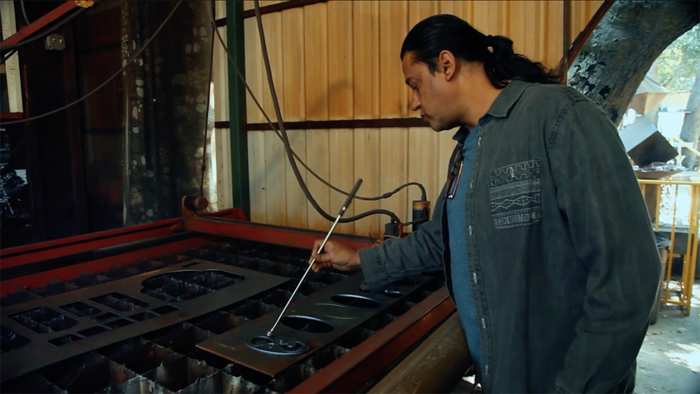
To see more of Jay Ryatt’s work or schedule a consultation, visit the Infinity Arts Studio website.

